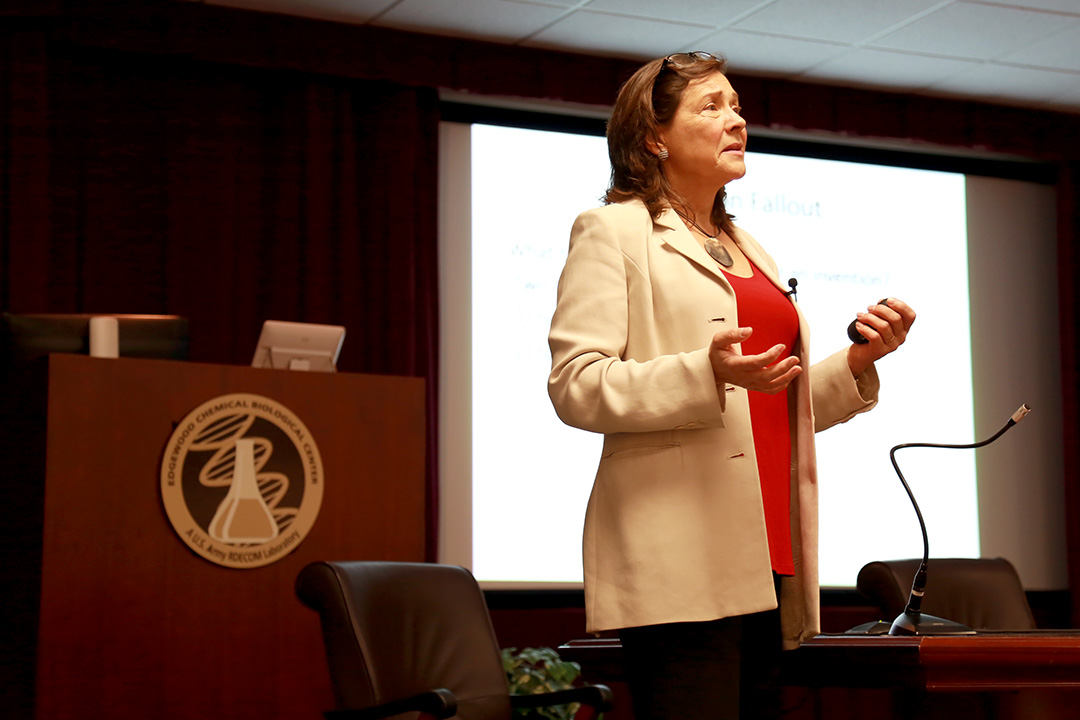// NEWS RELEASE
Guest Speaker: Scientific Innovation Often Takes Unexpected Paths
Naomi Halas, Ph.D, a leading nanotechnology researcher, remarks that accidents and failure are often the source of innovation.
CCDC Chemical Biological Center Public Affairs | June 14th, 2017
Guest Speaker: Scientific Innovation Often Takes Unexpected Paths
Naomi Halas, Ph.D, a leading nanotechnology researcher, remarks that accidents and failure are often the source of innovation.
DEVCOM CBC Public AffairsJune 14th, 2017

Naomi Halas, Ph.D., a leading nanotechnology researcher, speaks to the ECBC workforce as part of its 100-year anniversary Speaker Series.
ECBC employees learned from one of the nation’s leading nanotechnology researchers about the many unexpected ways science can be propelled forward at talk given at the Berger Auditorium on June 14. The event was part of the organization’s 100-year anniversary speaker series.
The speaker was Naomi Halas, Ph.D., the Stanley C. Moore Professor in Electrical and Computer Engineering and founding director of the Laboratory for Nanophotonics at Rice University. The title of her talk was the “The Future of Science.”
Among her examples was the fact that antibiotics was discovered in 1928 when a research scientist, Alexander Fleming, returned from a month-long vacation in Scotland. He had left behind cultures of staphylococci on a bench in a corner. Fleming noticed that one culture was contaminated with a fungus and that the colonies of staphylococci immediately surrounding the fungus had been destroyed, whereas other staphylococci colonies farther away were normal. He identified the fungus as Penicillin.
Another example she gave was the invention of the laser, which was created in 1953 by Charles Hard Townes by applying research going all the way back to Einstein. It was not put to any productive use for 25 years and seemed to be little more than a scientific curiosity. In fact, its very first use was to create the tiny hole in the nipples of baby bottles. Now it is essential in everything from eye surgery to telecommunications in space.
She also recounted the discovery of quasicrystals by Daniel Shechtman while he was on sabbatical at Johns Hopkins University in 1983. His colleagues there did not believe that an asymmetrical crystalline structure that can continuously fill all available space could possibly exist. The head of Shechtman ‘s research group told him to “go back and read the textbook” and a couple of days later asked him to leave for “bringing disgrace on the team.” Two-time Nobel Laureate, Linus Pauling, even said of him, “There is no such thing as quasicrystals, only quasi-scientists.” He persevered, publishing his findings. Gradually other scientists began to confirm his findings. Shechtman won the Nobel Prize in chemistry in 2011 for that discovery.
She also observed that most Nobel prizes go to scientists whose work appeared in lesser journals because they are not taking the safe path of research that elaborates on well-established theories. The lesson for the scientists attending her talk, she said, was, “Don’t follow other people, dotting i’s and crossing t’s. Make your own mark.” She added that the ability to for a scientist to communicate his or her work is just as important as the work itself.
Finally, she said that for scientists, “Role models are all around us, those we want to emulate, and those we know we don’t want to be like. Learn from anybody and everybody.”
The U.S. Army Combat Capabilities Development Command (DEVCOM) leads in the discovery, development and delivery of technology-based capabilities to enable Soldiers to win our nation’s wars and come home safely. DEVCOM is a major subordinate command of the U.S. Army Futures Command. The DEVCOM Chemical Biological Center is the Army’s principal research and development center for chemical and biological defense technology, engineering and field operations. The DEVCOM Chemical Biological Center is headquartered at Aberdeen Proving Ground, Maryland.
